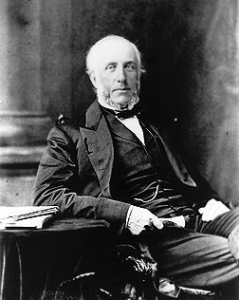Big Canadian newspaper chains struggle while some independent weeklies thrive

George Brown, a Canadian Father of Confederation, founded The Globe in 1844 in Toronto. In 1936, The Globe took over The Mail and Empire and became The Globe and Mail. Photo: Public Archives of Canada.
Newspapers in Canada are not what they used to be. In August, Toronto-based The Globe and Mail, which bills itself as “Canada’s National Newspaper,” announced it would no longer produce a print edition in the Atlantic provinces after November 30. Management claimed that printing and delivery costs are too high in Atlantic Canada. In January, the National Post, the other Toronto-based national newspaper, stopped producing a print edition on Mondays. Montreal’s La Presse, which was once known for being the largest French-language daily in North America, stopped its print edition on every day except for Saturday in 2015.
Who reads print editions?
News Media Canada, the national organization for the print and digital news business, says that 85 percent of Canadians read a newspaper using print and digital platforms. Depending on the time of day though, print is the second-least, or least-used platform and is in a tie with tablets. Most Canadians these days are reading newspapers on their phones. News Media Canada says that readers from the “baby boom” generation are the ones keeping print editions going, but notes that older readers are beginning to adopt digital, too.
The big chains cut big to survive
Newspaper ownership in eastern Ontario is dominated by two companies. The Toronto Star is owned by Torstar, a holding company that also owns Metroland, which in turn owns two dailies and over 100 community newspapers, including ones in Kemptville and Smiths Falls.
Postmedia, the parent company of the National Post, owns 43 daily papers including the Ottawa Citizen, Brockville Recorder and Times, the Cornwall Standard-Freeholder, and The Kingston Whig-Standard. Postmedia also owns 108 weekly papers, including ones in Prescott and Gananoque.
Newspapers owned by the big companies have taken on a more standard appearance in recent years. Many of the Metroland publications now just use the corporate logo with the name of the newspaper in the same font on their masthead. Postmedia websites have a similarly generic appearance. Corporate owners have cut staff significantly too, leaving a lot of hard news and community life to be ignored. And most papers owned by these companies are not printed in the communities they serve.
Small independents find a niche to hold their own
There are a couple of exceptions to the trend of local newspaper decline in eastern Ontario.
The Morrisburg Leader has been owned by the same family for over 150 years. Sam Laurin’s grandfather founded it and then his father took it over. In 1976, four of his sons took ownership as partners and now three of them run the paper.
“The Leader focuses on very local issues, South Dundas (town) council news, local sports, etc.,” said Laurin. They do have an online edition that features some of their stories (after they have first appeared in the print edition), along with a popular Facebook page. Laurin said that local owners who are involved in the community and well-trained local employees who remain at the paper for a long time are advantages his paper has that ones owned by big corporations do not.
 In Vankleek Hill, The Review has been owned by Louise Sproule for 24 of its 124 years. It’s an English-language newspaper in a majority French-speaking part of Ontario that also competes with three free local papers in the area.
In Vankleek Hill, The Review has been owned by Louise Sproule for 24 of its 124 years. It’s an English-language newspaper in a majority French-speaking part of Ontario that also competes with three free local papers in the area.
“We have a big focus on people” said Sproule, highlighting the deep attention the paper gives to local issues and events, along with a strong emphasis on editorial content. The Review regularly covers council meetings in three municipalities and constantly surveys nine others, on both sides of the Ontario-Quebec boundary for relevant stories. The bilingual reporting staff can cover events that are French-only, but write about them in English.
Sproule said one-third of their readers are people who speak French as a first language. English speakers in the Quebec communities appreciate the content, too. The paper’s commitment to the community is strong; it assists organizations and causes with free advertising, and sponsors community events.
Sproule acknowledged that it is cheaper to advertise online, but a print newspaper advertisement will get noticed because “it gets on the kitchen table” in the home where it will be read. Sproule said that a year ago, she was discouraged about the future, but things are “shifting” now. She hired a recent college business graduate who has improved the newspaper’s online interface and methods of payment for subscription.
The Review website does look extremely professional and is rich in content. A paywall limits most of the online content to paid subscribers, lessening the negative impact supporting a free web edition can have on a newspaper’s bottom line.
So while Canadian newspapers owned by big companies are in a state of decline, it seems local ownership, coverage, and commitment to community are keeping a couple of local papers in eastern Ontario strong.
Tags: canada, newspapers, Ontario










Pass it on. Cell phones are so yesterday. The cool people are tossing their cell phones and switching to rotary phones.